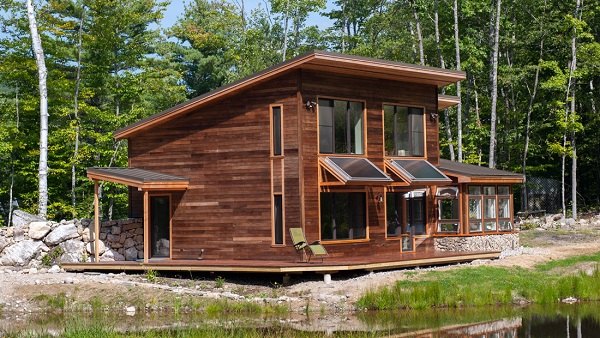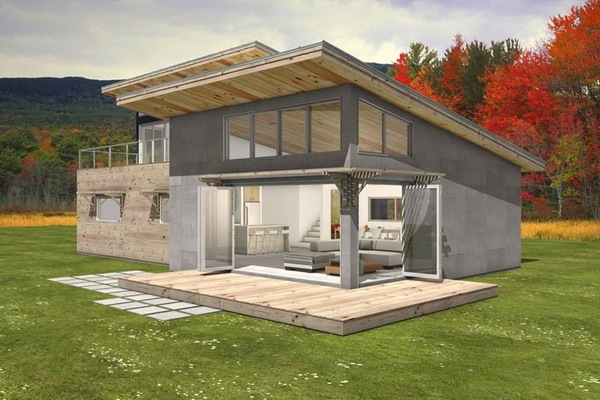Table Of Content
Large, open rooms with a minimum of walls, ceilings that slope upward with ventiliation at the top, and vents near the floor facilitate this. Second, sources of water vapor and heat should, as much as possible, be located outside of the living area. Boiling water on the stove, or a shower can fill the house with warm water vapor, which takes much energy to remove.
Passive solar heat transfer principles
Of course, every time a drain backed up or the winter wind shook the worn wooden structure, we couldn’t help dreaming of the beautiful, earth-sheltered, solar houses we kept reading about in books and magazines . And so we soon began to plan just how those energy-saving concepts might fit into our own home. While doing so, however, we all too frequently butted our heads against the same problem . About half of the year, from mid-April to mid-October is generally hot and humid.
How To Properly Evaluate Solar Panel Companies
Passive house plans are eco-conscious floor plans for homeowners who want to keep green living in mind when building. These homes typically have large windows to capture sunlight and other features that reduce the use of natural resources and increase overall efficiency. For example, instead of maximizing the windows’ size to allow more sunlight to strike the floors and walls, these buildings use a Trombe wall, which has a glass panel in front of the masonry, to maximize heat absorption. Insulated and laminated impact windows and doors do wonders for reducing a home’s overall energy consumption, explains Manny Angelo Varas, president and CEO of homebuilder MV Group USA. If you’re replacing windows in a home, take a closer look at triple-glazed windows, also known as triple-pane windows. “These have a much better insulation value, and with the right films, can cut down on not only solar heat gain but UV rays that can damage artwork, fabrics, and finishes,” says Schneeberger.
Carbon footprints: how to design low carbon and zero carbon homes
Mother Earth News is pleased to offer study plans for this beautiful, energy-efficient home. The traditional Prairie home style has its roots in the Midwest and is easily recognized by the linear horizontal design, roof overhangs and centrally located fireplaces. At about 2,600 square feet, this energy-efficient home has a floor plan design which allows it to be functional while minimizing the heated space and amount of construction materials. If located in the Great Lakes region, the Solar Prairie Home will require only about $600 per year to heat! Add solar thermal panels and you can cut your heating bill by a total of 75 percent!
If a passive house is designed well is it worth the extra cost for Low E window coatings?
Hyundai and Panasonic are trusted brands and they’ve both expanded into the solar panel industry. When you make the decision to install a solar panel system at your home, there are going to be several questions on your mind. Solar.com is committed to providing our customers with the best customer service experience in the solar industry. Household solar monitoring systems change the abstracts of power generation and consumption into graphics and numbers you can scroll through on an app.
The minimum R-factor in most climate zones should be R-19 walls and R-31 roofs. With SIPs, I like to use a minimum of 6-inch walls (R-24) and 8-inch roof panels (R-31). It’s also important to use perimeter-edge insulation (available at EnergyEdge) if building with concrete slab on grade, particularly if you’re using radiant floor heating. Some of my favorite high-quality windows are Loewen metal-clad wood windows, but all-vinyl windows are more economical and perform well. Double glazing is adequate for most climates, although in locations with severe winter conditions, triple glazing is advisable to reduce heat loss and condensation on the glass. Typically, you would locate the day-use rooms, such as a living room or family room, on the south portion of the home’s floor plan to allow the greatest amount of solar energy to penetrate these rooms on winter days.
Even if you put a floor covering on a concrete slab floor, you will still get the temperature balancing effects of thermal mass as long as it is insulated below, and therefore kept inside your building envelope. Darker colors are ideal for absorbing heat, but within the confines of a home, the heat collection advantage of darker floors is not that pronounced. When most people hear the words “municipal office building,” this image is usually the last thing that would come to anyone’s mind. However, this massive multi-unit working space has been specifically designed to maximize the amount of direct and indirect sunlight that reaches the building’s interior. While passive solar can heat the interior of a space, active solar designs are generally more efficient for heating water and can be used to generate renewable, off-grid electricity.
Tour this Boise Passive House - Wallpaper*
Tour this Boise Passive House.
Posted: Tue, 26 Mar 2024 07:00:00 GMT [source]
Designboom’s Earth Day 2024 roundup highlights the architects who continue to push the boundaries of sustainable design. All were created by architects who are well known and respected in the passive solar community. Properly oriented to the sun, homes built from passive solar floor plans require much less energy for heating and cooling.

Try to minimize the number of east and west facing windows if cooling is a major concern. Landscaping in general can be used to reduce unwanted heat gain during the summer. The “shell” of the house is composed of exterior insulated walls and “glazing,” or windows.
Passive solar heating is the main tenet of this form of home design and has to do with the way your home absorbs heat. The goal for this is to offset your heating and cooling requirements for when you want to use your AC. When planning and designing your passive solar home, you have to take into account the climate, location of your home, and materials being used in its construction. These factors all influence the way in which solar heat interacts with your home. In conclusion, passive solar design is one of the easiest building principles to implement and use in sustainable homes and buildings throughout the world.
Browse through our passive solar floor plans below or check out our other eco-friendly homes and take the next step towards leaving a smaller footprint with a more efficient home. Windows with Low-e coatings are more likely to retain indoor heat and will reduce the amount of solar radiation entering your house. These materials are referred to as “thermal mass” and are effective at retaining more heat. On the other hand, dwellings in warmer climates should use reflective materials to keep the house cool in the summer.
A solid vertical panel is placed perpendicular to the wall, between two windows. It accelarates natural wind speed due to pressure differences created by the wing wall. Unlike active solar heating systems, passive systems are simple and do not involve substantial use of mechanical and electrical devices, such as pumps, fans, or electrical controls to move the solar energy.
One of the first questions you’ll be asked in the process of going solar is, “What is your roof made of? During the seasons where you are heating your home and covered during the months when you are planning to cool your home down. All that is to say, don’t worry too much about the color of your floor, or by putting a floor covering over your slab that makes you more comfortable and happy.
Numerous publications and pamphlets are available through FSEC for a very small fee. Also, their Building Design Assistance Center (BDAC) offers free design assistance (which we have taken advantage of). Another resource that had a large influence on the design of our house was a book by University of Florida Professor Ronald W. Haase entitled "Classic Cracker - Florida's wood-frame vernacular architecture". In particular, a design featured in that book by architect Edward J. Seibert, was the inspiration for our house.
External shading, or a radiant barrier plus air gap, may be used to reduce undesirable summer solar gain. Traditionally a heliodon was used to simulate the altitude and azimuth of the sun shining on a model building at any time of any day of the year. GPS-based smartphone applications can now do this inexpensively on a hand held device. These design tools provide the passive solar designer the ability to evaluate local conditions, design elements and orientation prior to construction.

A good thermal connection between the inside wall finishes (e.g., drywall) and the thermal mass wall is necessary to maximize heat transfer to the interior space. A classical Trombe wall, also generically called a vented thermal storage wall, has operable vents near the ceiling and floor levels of the mass wall that allow indoor air to flow through them by natural convection. As solar radiation heats the air trapped between the glass and wall and it begins to rise. Air is drawn into the lower vent, then into the space between the glass and wall to get heated by solar radiation, increasing its temperature and causing it to rise, and then exit through the top (ceiling) vent back into the indoor space. This allows the wall to directly introduce heated air into the space; usually at a temperature of about 90 °F (32 °C). The main source of heat transfer is radiant energy, and the primary source is the sun.
No comments:
Post a Comment